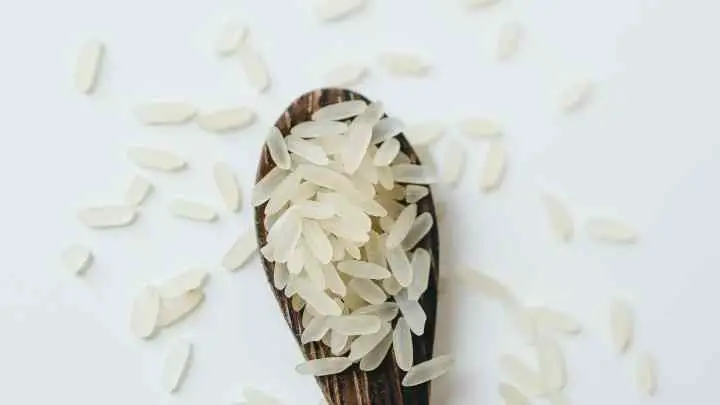Are you planning a small event or curious to know the grams in 1/2, 1, 2, 3, 4, and 5 cups of rice?
Yes, a cup of rice can be measured in grams, and it’s one of the best ways to ensure you do not go overboard with your measurements or end up with unnecessary leftovers.
If you’re trying to follow a cookbook recipe, this guide still applies to you and can help you familiarize yourself with the right measurements.
Without further ado, let’s get started.
What is the gram (mass)?
Gram is popularly known as a unit of mass in the International System of Units (SI) (metric system). The term “Gram” hails from the Greek word “gramma,” meaning “a small weight.”
One gram is equal to 1,000 (one thousandth) of a kilogram, which is about the mass of one cubic centimeter (cm3) of water at 4 degrees celsius.
Also, the SI unit of mass is widely known as the kilogram (kg).
What is a cup?
A cup is a measurement of volume. “Cup” comes from the Latin word “cuppa,” meaning “drink.” There are different types of cups, such as teacups, coffee, measuring, and drinking cups.
One cup is equal to the volume of a cube with sides that are 2-1/2 inches (6.35 centimeters) in length. This is the equivalent of 8 fluid ounces (237 milliliters) in the U.S. customary system or 250 milliliters in the metric system.
A cup is a customary unit of measurement in the United States, but it is not part of the International System of Units (SI).
In recipes, an important distinction is usually made between a liquid cup and a dry cup. Later, we’ll look at common conversions for cups to grams (g) of uncooked rice.
What is a rice cup?
A rice cup is a small, handheld container that measures rice to cook. It typically holds between two and four ounces of rice, making it the perfect size for individual servings.
Rice cups usually have a spout or pour spout for easy measuring and pouring, and some models even come with a built-in filter.
You’ll need a rice cup for the following reasons:
- They’re incredibly lightweight and portable, making them ideal for cooking rice on the go.
- They are also helpful at times when you need to know the grams in 1/2 – 5 cups of rice before cooking.
- They’re very affordable, with most models costing less than $20.
- They make it easy to measure out portion sizes of rice without any mess or fuss.
How many grams in 1/2 cup of rice?
| Rice | Grams (rounded up) |
| White long rice | 92 and a 1/2 |
| White medium rice | 97 and a 1/2 |
| White short round rice | 100 |
| Brown rice | 95 |
| Basmati rice | 97 and a 1/2 |
| Jasmine rice | 97 and a 1/2 |
How many grams in 1 cup of rice?
| Rice | Grams (rounded up) |
| White long rice | 185 |
| White medium rice | 195 |
| White short round rice | 200 |
| Brown rice | 190 |
| Basmati rice | 195 |
| Jasmine rice | 195 |
How many grams in 2 cups of rice?
| Rice | Grams (rounded up) |
| White long rice | 370 |
| White medium rice | 390 |
| White short round rice | 400 |
| Brown rice | 380 |
| Basmati rice | 390 |
| Jasmine rice | 390 |
How many grams in 3 cups of rice?
| Rice | Grams (rounded up) |
| White long rice | 555 |
| White medium rice | 585 |
| White short round rice | 600 |
| Brown rice | 570 |
| Basmati rice | 585 |
| Jasmine rice | 585 |
How many grams in 4 cups of rice?
| Rice | Grams (rounded up) |
| White long rice | 740 |
| White medium rice | 780 |
| White short round rice | 800 |
| Brown rice | 760 |
| Basmati rice | 780 |
| Jasmine rice | 780 |
How many grams in 5 cups of rice?
| Rice | Grams (rounded up) |
| White long rice | 925 |
| White medium rice | 975 |
| White short round rice | 1000 |
| Brown rice | 950 |
| Basmati rice | 975 |
| Jasmine rice | 975 |
Benefits of measuring your rice before cooking it
- You will save time: When you know exactly how much rice you need, you can save time by not cooking too much or too little.
- You will save money: Measuring your rice means you will only cook the amount you need. This can save you money, mainly when tight on a budget.
- You can control your portion sizes: If you are trying to watch your weight or eat healthier, measuring your rice will help you control your portion sizes.
- You can make sure your rice is cooked evenly: When you measure your rice, you can make sure that all the grains are cooked evenly. This ensures that your rice is not overcooked or undercooked.
- You can experiment with different ratios of water to rice: Measuring your rice allows you to experiment with various ratios of water to rice. This can help you find the perfect ratio for your taste.
SEE: What Can Sella Rice Do For Your Diet?
FAQs
Are 2 cups of rice the same as 2 cups of water?
No, they are not the same. The amount of rice that fits in a cup can vary depending on the type and size of the grain. A cup of water will be the same, no matter the size or type of the cup. As a rule of thumb, always add two cups of water to every cup of rice you cook.
Is it compulsory to measure your rice at all times?
No, it’s not compulsory. You can cook rice without measuring it, and it will still turn out just fine. You might need to measure your rice if you follow a recipe that requires a specific amount. Other than that, feel free to cook rice without measuring it.
How many grams of rice is recommended for one person to eat?
Preferably, start with 50-75 grams of uncooked rice per serving. As time goes on you can decide to increase or reduce the quantity.
Can rice be measured only in grams?
No, you can also measure rice in pounds. However, to some, grams are the most accurate way to measure rice, as grains can vary in how much they weigh.
Conclusion
Rice is a staple food in many cultures around the world. It is simple to make and can be very versatile. Whether you are looking to save money, cook the perfect amount of rice, or avoid overcooking or undercooking your rice, measuring it before cooking is a good idea.
I hope this guide has helped answer how many grams are in 1/2, 1, 2, 3, 4, and 5 cups of rice. Remember, the amount of rice that fits in a cup can vary depending on the type and size of the grain.
When in doubt, start with 50-75 grams of uncooked rice per serving and adjust from there. Preferably, you can bookmark this guide for future reference.
Thank you for reading.
Did you enjoy reading this? There’s more on Cheffist.






